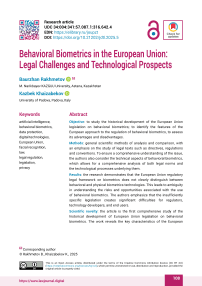Behavioral Biometrics in the European Union: Legal Challenges and Technological Prospects
Автор: Rakhmetov B., Khaizabekov K.
Журнал: Journal of Digital Technologies and Law @lawjournal-digital
Статья в выпуске: 3 (1), 2025 года.
Бесплатный доступ
Objective: to study the historical development of the European Union legislation on behavioral biometrics; to identify the features of the European approach to the regulation of behavioral biometrics, to assess its advantages and disadvantages. Methods: general scientific methods of analysis and comparison, with an emphasis on the study of legal texts such as directives, regulations and conventions. To ensure a comprehensive understanding of the issue, the authors also consider the technical aspects of behavioral biometrics, which allows for a comprehensive analysis of both legal norms and the technological processes underlying them. Results: the research demonstrates that the European Union regulatory legal framework on biometrics does not clearly distinguish between behavioral and physical biometrics technologies. This leads to ambiguity in understanding the risks and opportunities associated with the use of behavioral biometrics. The authors emphasize that the insufficiently specific legislation creates significant difficulties for regulators, technology developers, and end users. Scientific novelty: the article is the first comprehensive study of the historical development of European Union legislation on behavioral biometrics. The work reveals the key characteristics of the European approach, its strengths and weaknesses, and compares it with the United States’ regulatory practice. The study reveals the key aspects that require further regulation: from a clear definition of behavioral biometrics to the development of comprehensive mechanisms to ensure transparency and accountability in the use of these technologies. Given that behavioral biometrics is a relatively new and rapidly developing technology, the research is important for understanding current challenges and prospects for its regulation. Practical significance: the research is multifaceted and relevant for experts in digital technologies: legal scholars, law enforcement officers, legislators, and developers of artificial intelligence and biometrics technologies.
Artificial intelligence, behavioral biometrics, data protection, digital technologies, European Union, facial recognition, law, legal regulation, legislation, privacy
Короткий адрес: https://sciup.org/14131900
IDR: 14131900 | УДК: 34:004:341:57.087.1:316.642.4 | DOI: 10.21202/jdtl.2025.5


